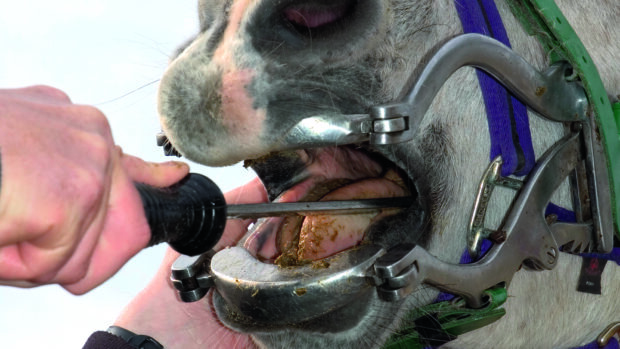Have you ever wondered how your horse manages to eat his hard feed but leave his medicine at the bottom of his feed bucket? Here’s what you need to know about your horse’s tongue — a vital yet often over-looked part of the equine anatomy
1. The horse’s tongue is made up of more than a dozen different muscles and is a highly specialised working tool.
2. The mobile front section works together with the horse’s teeth and lips to select and pick up feed or nip off blades of grass. They are adept at eating only the choicest bits of food.
3. The frenulum, where the tongue starts to attach to the underlying tissue, plays a vital role in chewing and swallowing.
4. Specialised protuberances called papillae, which cover the entire upper surface of the tongue, help guide food into position before it is pressed up against the ridged roof of the mouth.
5. This forces food on to the chewing surfaces of the teeth, where it is ground down and passed across the tongue again and towards the rear of the oral cavity in a spiral motion.
6. The now thoroughly pulped food encounters a thickened area of the tongue called the lingus, which pushes it back for swallowing.
7. Despite being covered by a thick membrane (muscosa), the tongue is an extremely sensitive organ and detects pain, heat, pressure and taste.
8. It also plays an important part in keeping the teeth clean as the horse moves it around to dislodge remnants of food.
Common causes of tongue injuries
9. Bits are the most common cause, perhaps through harsh rein action or because the horse is tied by or tangled in the reins and pulls back.
10. Teeth are a cause too. The horse may accidentally bite his tongue if he falls or is kicked.
11. Holding the tongue can help immobilise the horse’s head and keep his mouth open, but if pulls away he may bite it. The pulling force could also cause neural damage.
12. Lacerations can be the result of a sharp object while the horse browses for food, or a superficial — but often very sore — cut if his tongue rubs against a sharp tooth.
Like this? You might also enjoy reading these:
The Chifney bit: useful or dangerous?
Subscribe to Horse & Hound magazine today – and enjoy unlimited website access all year round
13. Foreign bodies such as thorns, twigs and the awns of some wild grasses can become lodged in the tongue.
14. Younger horses and foals in particular tend to nibble and chew on things they shouldn’t, so check hay for foreign objects and remove any debris from your yard.




